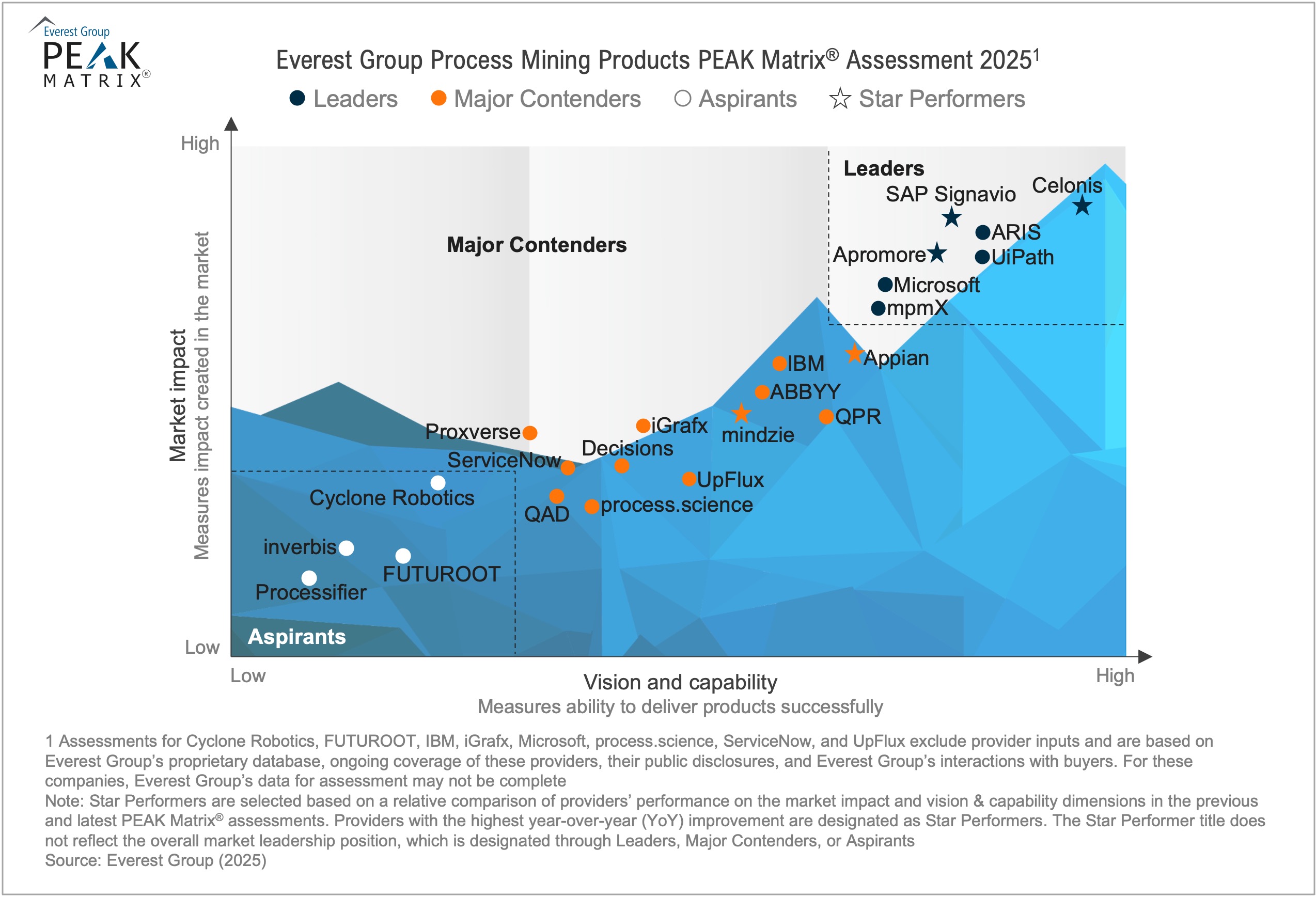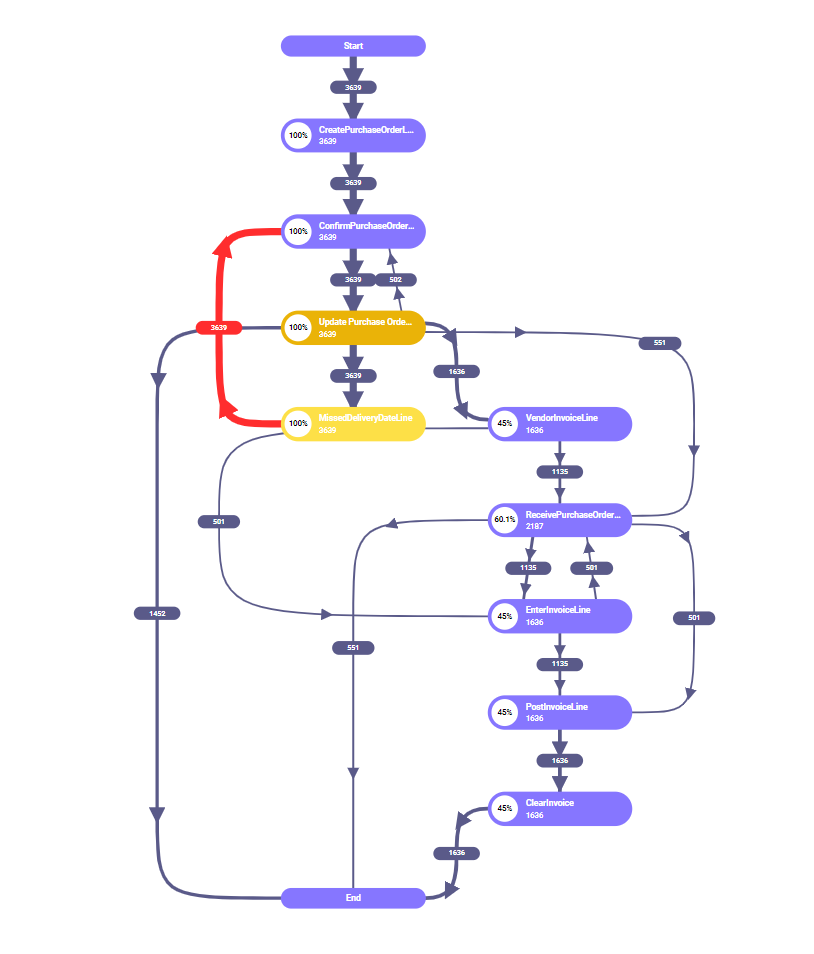Exploring the Key Process Mining Algorithms and How They Work
Process mining algorithms are like “formulas” or “rules” that process mining tools use to analyze the data from your business systems and create a picture of how your processes work. Different algorithms approach the data in slightly different ways, depending on what you want to learn.
Choosing the right algorithm is key, as different ones are suited for various use cases. In this article, we’ll explore some of the most popular process mining algorithms and how they can be applied to real-world problems.

Alpha Miner
- How it works: It looks at the order of events to find patterns.
- Best for: Simple processes with clear start and end points.
- Limitations: Doesn’t handle complex or messy data well.

Alpha Miner is one of the earliest and most well-known algorithms in the field of process mining. It was designed to discover process models from event logs by focusing on the causal relationships between activities. Alpha Miner uses a formalized approach to derive a Petri net model, which visually represents the process and its control flow. Although it is no longer the most advanced algorithm, it laid the foundation for later process mining techniques.
How Alpha Miner Works in Process Mining
Alpha Miner works by analyzing event logs to construct a Petri net, a mathematical model that captures the flow of activities within a process. The algorithm identifies direct dependencies between activities based on the order of events in the log and creates a causal net, representing the sequence of activities. It looks for patterns such as parallelism, choice, and loops, while considering data such as timestamps and activity transitions.
Key Requirements:
- Event Logs: Alpha Miner requires a well-structured event log containing information about events, timestamps, and case IDs.
- Petri Net Model: The algorithm outputs a Petri net model that depicts the process flow.
Pros of Alpha Miner:
- Clear and Understandable Models: The Petri net model it generates is relatively easy to interpret and provides a clear view of the process.
- Pioneering Algorithm: Alpha Miner was one of the first algorithms to formalize process discovery and laid the groundwork for further research.
Cons of Alpha Miner:
- Sensitive to Noise: Alpha Miner struggles with noisy or incomplete event logs, often leading to inaccurate or overly complex models.
- Limited Scalability: It may not perform well with large or highly complex datasets due to the constraints of its formal approach.
- No Support for Complex Constructs: The algorithm has difficulty handling complex process structures like loops, duplicates, and long-running processes effectively.
Heuristic Miner
- How it works: It analyzes event frequencies and identifies the most common paths.
- Best for: Processes with some noise (unusual events) or variations.
- Limitations: Might oversimplify rare but important cases.

Heuristic Miner is an algorithm designed to address some of the limitations of Alpha Miner, particularly when dealing with noisy or incomplete event logs. It focuses on discovering process models by considering the frequency and relationships between activities rather than strictly enforcing a causal structure. This makes it more robust when handling imperfect or noisy data, which is common in real-world business processes.
How Heuristic Miner Works in Process Mining
Heuristic Miner extracts process models by analyzing the frequency of activity pairs in the event log. It identifies direct dependencies between activities based on how often they occur together and in what order, creating a process model that reflects the most frequent patterns observed in the data. Unlike Alpha Miner, which uses strict causal relationships, Heuristic Miner relies more on observed co-occurrences and transitions between activities. The algorithm can detect parallelism, choices, and other process constructs by looking at the frequency of different event sequences.
Key Features:
- Frequency-Based: Heuristic Miner is based on the idea that more frequent activity pairs are more likely to reflect true process behavior.
- Noise Tolerant: It is well-suited for event logs with noise, as it does not require perfectly clean data to generate useful models.
Pros of Heuristic Miner:
- Handles Noisy Data Well: The algorithm performs better than Alpha Miner in environments with noisy or incomplete event logs.
- Less Strict: It does not require perfect causal relationships, making it more flexible in identifying process patterns.
- Efficient for Large Logs: Heuristic Miner can handle larger event logs with greater ease, as it focuses on frequency rather than a detailed causal model.
Cons of Heuristic Miner:
- Less Precise Models: The models generated may not be as precise or exact as those produced by other algorithms like the Alpha Miner or Inductive Miner.
- May Miss Complex Dependencies: It may overlook more intricate dependencies between activities, especially in highly complex processes.
- Dependence on Log Quality: While robust to noise, the quality of the log still influences the output; very poor or sparse logs may still lead to inaccurate models.
Fuzzy Miner
- How it works: It focuses on simplifying very complex processes by grouping similar steps.
- Best for: Processes with lots of variations or when you want a high-level overview.
- Limitations: Can hide too much detail if you need specific insights.

Fuzzy Miner is an algorithm specifically designed to handle large, complex, and noisy event logs. Unlike other process mining algorithms, Fuzzy Miner aims to create simplified, yet meaningful process models that capture the essential aspects of the process without getting bogged down by unnecessary details. It is particularly useful when dealing with highly complex or cluttered event data, where traditional algorithms might produce overly detailed or unreadable models. Fuzzy Miner helps organizations focus on the core patterns and behavior of their processes.
How Fuzzy Miner Works in Process Mining
Fuzzy Miner operates by simplifying the process model while retaining the key information needed to understand the process flow. It does this by analyzing the event log and identifying the most important activity relationships, then creating a process model that reflects only these significant relationships. This results in a process model that is more abstract, highlighting the main trends and interactions while ignoring less critical data or minor variations. The algorithm uses a fuzzy approach, allowing for flexibility in how it aggregates and simplifies the event data, making it less sensitive to noise and irrelevant details.
Key Features:
- Simplified Models: Fuzzy Miner generates abstract models that retain the key process elements, providing a clearer, high-level view of the process.
- Noise-Tolerant: It focuses on the most important relationships, reducing the impact of noisy or irrelevant data in the event log.
Pros of Fuzzy Miner:
- Handles Large and Complex Logs: Fuzzy Miner is well-suited for complex, large-scale event logs where traditional algorithms might fail to produce comprehensible models.
- Creates Understandable Models: By simplifying the process model, Fuzzy Miner helps users focus on key process flows without being overwhelmed by too much detail.
- Noise-Resistant: It is more robust against noise and anomalies in the data, making it a good choice for real-world, messy logs.
Cons of Fuzzy Miner:
- Loss of Detail: In simplifying the process model, some less obvious but potentially important details may be overlooked or omitted.
- Limited Precision: Because of its abstraction, Fuzzy Miner may not capture every nuance of the process, which could be a limitation in cases where precise, detailed analysis is required.
- Requires Careful Configuration: To strike the right balance between simplification and accuracy, the algorithm may require careful tuning to avoid over-simplifying the model.
Inductive Miner
- How it works: It builds a structured and detailed model of the process based on event data.
- Best for: Processes with both simple and complex paths, giving detailed insights.
- Limitations: Might take longer to process large datasets.

Inductive Miner is an algorithm widely known for producing “sound” Petri nets, which are mathematically consistent and ensure that the generated process models accurately represent the event log. A sound Petri net is one where all transitions are reachable from the initial state, and there are no deadlocks or invalid process states. This makes Inductive Miner particularly valuable in scenarios where the correctness and completeness of the process model are critical. It is often used in applications that require precise, reliable process models.
How Inductive Miner Works in Process Mining
Inductive Miner works by recursively decomposing the event log into smaller and smaller fragments and then inductively discovering a process model for each fragment. The process begins by identifying the most frequent and significant behavior within the log, and then it progressively breaks down the process into smaller subprocesses. Each of these subprocesses is modeled individually, and the results are combined to form the overall process model. This approach ensures that the final model is both accurate and manageable. By focusing on smaller, more manageable pieces of the process, Inductive Miner produces process models that reflect the true underlying behavior of the system, with minimal assumptions and abstractions.
Key Features:
- Sound Petri Nets: The algorithm generates process models that are both structurally sound and free from inconsistencies or errors.
- Recursive Decomposition: The event log is broken down into smaller fragments to simplify the discovery process while maintaining the overall process structure.
Pros of Inductive Miner:
- High Accuracy: Inductive Miner is excellent at creating process models that are accurate and reflect the true nature of the event log, with no logical flaws.
- Petri Net Models: The algorithm generates sound Petri nets, which are widely used for their formal verification and analysis capabilities.
- Scalable: It handles complex event logs well by decomposing them into smaller, more manageable parts.
Cons of Inductive Miner:
- Sensitive to Noise: Although it produces sound models, the algorithm can be sensitive to noise and incomplete data, which might lead to overly simplified or incorrect models in the presence of poor-quality logs.
- Computationally Intensive: The recursive decomposition process can be computationally expensive, particularly when working with large event logs.
- Complexity in Output: While the generated models are highly accurate, they may become complex and harder to interpret for non-expert users, especially when dealing with intricate process structures.
Genetic Miner
- How it works: Genetic Miner analyzes event data to create a detailed and organized model of your process, helping you understand how it operates.
- Best for: It’s ideal for processes with simple or complex paths, providing valuable, detailed insights.
- Limitations: Processing large datasets can take more time, which may impact efficiency.

- Sensitive to Noise: Although it produces sound models, the algorithm can be sensitive to noise and incomplete data, which might lead to overly simplified or incorrect models in the presence of poor-quality logs.
- Computationally Intensive: The recursive decomposition process can be computationally expensive, particularly when working with large event logs.
- Complexity in Output: While the generated models are highly accurate, they may become complex and harder to interpret for non-expert users, especially when dealing with intricate process structures.
How Genetic Miner Works in Process Mining
Genetic Miner operates by first generating an initial population of random process models based on the event log data. These models are then evaluated based on their fitness, which measures how well they represent the actual behavior of the process. Over successive generations, the algorithm selects the best models, applies genetic operations such as mutation (introducing random changes) and crossover (combining features of two models), and produces a new population of models. This evolutionary process continues until an optimal or sufficiently accurate process model is found. The result is a process model that best fits the event log, with potential for capturing more complex process behavior that other algorithms might miss.
Key Features:
- Genetic Algorithms: Genetic Miner uses evolutionary techniques to evolve and optimize process models.
- Iterative Improvement: The process models are refined over multiple generations to ensure accuracy and complexity handling.
Pros of Genetic Miner:
- Captures Complex Processes: Genetic Miner is capable of discovering complex, non-linear process behaviors that other algorithms might overlook.
- Flexibility: The use of genetic algorithms allows the model to evolve and adapt to the specific characteristics of the event log, providing flexibility in discovering process patterns.
- Handles Large and Noisy Logs: The evolutionary process can help the algorithm deal with large and noisy event logs, making it robust in real-world applications.
Cons of Genetic Miner:
- Computationally Intensive: The iterative nature of genetic algorithms can be computationally expensive, particularly with large datasets.
- Requires Tuning: The performance of Genetic Miner heavily depends on the parameters used in the genetic algorithm, which might require careful tuning to achieve the best results.
- Complexity of Output: The process models produced by Genetic Miner can be complex and difficult to interpret, especially for users without a background in process mining or genetic algorithms.
How to Choose the Best Algorithm for Mining
Selecting the right process mining algorithm depends on various factors such as the size of the event log, the quality of the data (noise levels), the complexity of the process, and the desired outcome (e.g., accuracy vs. simplicity). Here’s a guide to help you choose the best algorithm for your specific needs:
1. Event Log Size
- Small Event Logs:
- Alpha Miner is a good choice if you have a small, clean event log with relatively straightforward processes. Its simplicity and focus on causal relationships make it ideal for small-scale processes.
- Large Event Logs:
- Heuristic Miner or Inductive Miner are better suited for larger logs. Heuristic Miner handles noise well and can scale, while Inductive Miner ensures soundness and consistency when breaking down complex processes into smaller, manageable fragments.
- Genetic Miner can also be used for large logs, especially if the process is highly complex, though it can be computationally intensive.
2. Noise Levels in Data
- Low Noise (Clean Data):
- Alpha Miner or Inductive Miner work well with clean logs because they focus on deterministic relationships and provide high accuracy in well-structured data.
- High Noise (Noisy or Incomplete Data):
- Heuristic Miner and Fuzzy Miner excel in noisy environments. Heuristic Miner uses frequency-based patterns to identify process behavior, while Fuzzy Miner simplifies the process model to capture the essential elements without being overwhelmed by noise.
- Genetic Miner is also a good option in highly noisy data because its evolutionary process can help adapt the model to the imperfections in the log.
3. Process Complexity
- Simple Processes:
- Alpha Miner or Heuristic Miner are good choices for processes with straightforward workflows and limited variations. These algorithms can generate simple, interpretable models without unnecessary complexity.
- Complex Processes:
- Inductive Miner and Genetic Miner are ideal for more complex processes. Inductive Miner produces sound Petri nets and works well for breaking down intricate processes into understandable parts. Genetic Miner, with its ability to explore multiple solution spaces using evolutionary principles, is excellent for highly complex, non-linear processes.
4. Desired Outcome: Accuracy vs. Simplicity
- High Accuracy (Precise Process Models):
- Inductive Miner is the best option when high accuracy is required. It creates sound, detailed Petri nets that reflect the true process behavior with minimal assumptions.
- Genetic Miner can also provide highly accurate models by iteratively refining the process model to fit the event log data.
- Simplicity (Simplified Process Models):
- Fuzzy Miner is the ideal choice for simplifying complex models while retaining the essential process information. It’s perfect for those who need an abstract overview of the process, free from the clutter of unnecessary details.
- Heuristic Miner can also provide a simplified model by focusing on frequent patterns and ignoring less significant relationships.
5. Scalability
- Small to Medium-Sized Logs:
- Alpha Miner and Inductive Miner are generally scalable to small and medium-sized logs without significant performance issues.
- Large Event Logs:
- Heuristic Miner and Genetic Miner handle large event logs better, although Genetic Miner might require more computational resources due to its iterative nature.
Summary Framework:
- For small, clean, and simple processes: Choose Alpha Miner for accuracy and simplicity.
- For large or noisy logs: Choose Heuristic Miner for noise resilience and scalability or Fuzzy Miner for simplicity in large, noisy datasets.
- For complex processes requiring sound models: Choose Inductive Miner for detailed and sound Petri nets.
- For highly complex, non-linear processes: Choose Genetic Miner for flexibility and the ability to evolve a process model based on evolutionary principles.
Conclusion
Choosing the right process mining algorithm is essential for uncovering insights and optimizing processes. Each algorithm serves specific needs:
- Alpha Miner is great for small, clean logs with simple processes.
- Heuristic Miner handles noisy data and large logs effectively.
- Fuzzy Miner excels in simplifying complex processes for clarity.
- Inductive Miner generates precise and sound models for complex workflows.
- Genetic Miner offers flexibility for highly complex, non-linear processes.
While selecting the right algorithm depends on your goals and data characteristics, using the right tools can simplify the process. Naturally, Mindzie’s process mining software provides a robust platform to apply these algorithms effortlessly. It’s designed to help businesses analyze, monitor, and improve processes efficiently, regardless of complexity.
Daniel is a 20 year ventran in enterprise software sales with over 7 years experience helping businesses drive operational excellence.



